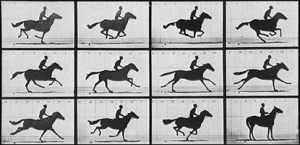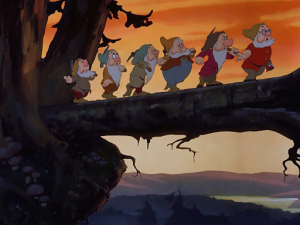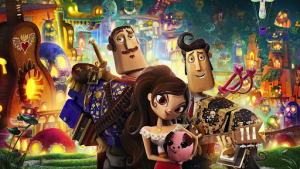Animation is the process of manipulating static images and combining them to form the illusion of motion. Each successive image in an animation sequence often has minor changes compared to the one preceding it. The more the number of these images, and the quicker these images are run in a sequence, it creates an illusion in our mind making us not realize what we are seeing is a collection of static images but a continuous movement.
Animation has existed for years. It got its origin in a photographer who wanted to test whether a horse running has all four of its legs up in the air at any point. So, the photographer decided to take rapid photographs of the horse running and found out that the horse did indeed, at points, raise all four legs in the air.

© Dover Publications
But what he also found out was that if he played all the images one after the other, it simulated movement.
From this, a few years on, 2D animation was born. A few more years passed, and 3D animation was born.
But what is the difference between 2D animation and 3D animation?
Let’s explore in-depth.

© Disney
2D animation, to put it in the simplest ways, is animation done in a 2D space.
Let us elaborate. We, humans, perceive the world in three dimensions. These include height, width, and depth. A 2D space is something that is devoid of this third dimension: depth. Hence the word 2D, which stands for two dimensions.
In 2D, movement within the scene is restricted. As a result, the overall animation sequence also has a distinct look.
2D animation has a very long and illustrious history. These were initially popularized around the world with the movies and shows from Disney. Most of us are indeed familiar with characters like Mickey Mouse, Daffy Duck, Goofy, Minnie Mouse, Snow White, etc.
Apart from these early movies, there are also numerous other games and movies that have been released in modern times, all having a 2D animation style. Some examples include movies like South Park and Persepolis and games like Shovel Knight and Orri and the Blind Forest.

© 20th Century Fox
3D animation is the type of animation that utilizes the third dimension we mentioned here: depth.
This style of animation is most noted for its realism and immersion. Even though it encompasses a lot of different art styles, it is nonetheless most noted and adopted for being closer to real life than 2D.
However, the industry didn’t immediately adopt 3D the moment it arrived on the scene. It took the animation and gaming industry a few years to slowly adopt this new animation style. Particularly in games, as real-time rendering meant devices had to be extra powerful to render 3D animation sequences.
In the past few years, 3D games have even penetrated the mobile game market as smartphones have become more powerful.
Notable 3D media include movies from Pixar, such as Toy Story and Wall-E, and games, such as GTA V and Fortnite.
In terms of popularity, there is a misconception that 3D is more popular than 2D by a long mile. This fact is simply not true. It is also based on a misguided assumption that 3D is somehow superior to 2D.
The fact of the matter is that both 2D and 3D are popular. 2D holds a special place in animation for its unique aesthetic, making it suitable and more apt for certain narratives than 3D. Likewise, 3D also has certain unique points about it that make it more suitable for certain forms of games and media, such as first-person shooter video games.
Thus, the debate of 3D animation vs. 2D animation in terms of popularity is a pointless one. There are many 2D animation companies and 3D animation companies that are thriving.
Despite the differences, the fundamental principles of animation for 2D and 3D remain the same. Both operate on principles such as timing, spacing, squash, anticipation, etc.
However, these principles reflect differently in 2D vs in 3D animation. Each has its own specificities unique to them.
The major difference, as we have mentioned before, is depth. 2D is completely devoid of depth and hence has a different aesthetic. Meanwhile, 3D has depth and utilizes it in a unique way.
The method of creation also differs between 2D and 3D animation.
In the past, 2D animation was created using a technique called cel-shading. Under this technique, each frame was manually drawn, and then they were all combined to form the desired sequence.
The practice is rare these days. Most of the 2D animation created today follows one of two approaches: frame-by-frame animation or skeletal animation.
Frame-by-frame animation is the technique of creating 2D animation by designating select key poses and then tweening the frames in between. Under this method, the animator pre-defines a few poses within the animation sequence. Then, the visual editing software that is used tweens the frames in between, thus creating a fluid animation sequence.
The latter method, i.e., skeletal animation, is a method where the 2D objects are rigged with controls. By moving these rigs, the object also moves, and thus, animators are able to create realistic animation sequences.
3D animation also follows a similar method. The 3D models, once created, are fitted with skeletal rigs that allow the animators to create complex facial expressions, body movements, and effects.
Generally, 2D is less time-consuming compared to 3D.
This is because of a myriad of reasons. One is that 2D assets require less detailing compared to 3D assets due to the lack of a third dimension and also lower expectations in terms of matching to pre-conceived standards of realism. Second is that 2D animation also requires less time to animate as a lot of processes in between, such as rigging and texturing, either are time-consuming or do not exist altogether.
However, this is not a rule that is set in stone. There are numerous 2D games and movies that have taken their creators years to develop. Likewise, the introduction of newer visual editing software has cut down the time required to create 3D games and other media much more drastically than before.
The difference between 2D and 3D animation in relation to time is also directly related to complexity.
Because of the reduced complexity, 2D animation requires lesser time compared to 3D animation on average.
Hardware is a critical factor for animation creation and for running games.
The fact of the matter is that 3D requires higher processing and graphical power. So, the development of a 3D video or game requires powerful systems that, for 2D animation creation, might be overkill.
In games, this is true in a bigger proportion. Since games are rendered in real-time, the system needs to create a lot of calculations quickly in order for the proper visual output to be visible on the screen. 3D games require a far higher number of these calculations on average, and hence the hardware requirements of modern 3D games are much higher than that of 2D games.
There is a lot of difference in terms of the software being used as well. There is a lot of difference in the software being used for 2D and 3D development.
In 2D animation, the dominant visual editing software includes Spine, Toonboom, Pencil 2D, OpenToonz, etc.
In 3D animation, meanwhile, popular software includes Blender, 3Ds Max, Maya, Cinema4D, and Unreal Engine.
Each of these software has its own specialties and weaknesses. The specific software is introduced to each project based on how tailored they are to the project’s requirements.
There is a difference between 2D and 3D animation in terms of the process as well.
The majority of the 2D animation creation process revolves around sketching the assets. Once the assets are completed, the skeletal rig is added if required, and the team moves on to the animation.
On the other hand, in 3D, there is a multi-step process that has to be completed prior to the animation process. The 3D models have to be created, the textures and material properties have to be added, and the rigs have to be created. Then the team moves on to the animation phase.
As we illustrated in this blog, there are a lot of differences between 2D and 3D animation. There are a few key similarities as well.
These differences do not mean that both are in competition with each other and that one is superior to the other. Each has a special place in media, be it games or movies. Each is preferred by companies, be it a game art outsourcing studio, 2D animation company, or a 3D animation company.
This is the reason both types of animation are used around the world. They will still be used for years to come.
Juego Studios can help you out. We offer animation services in both 2D and 3D for games, interactive applications, and other solutions. Our team of animators is skilled at different visual editing software and classic animation principles, thus creating quality output every single time.